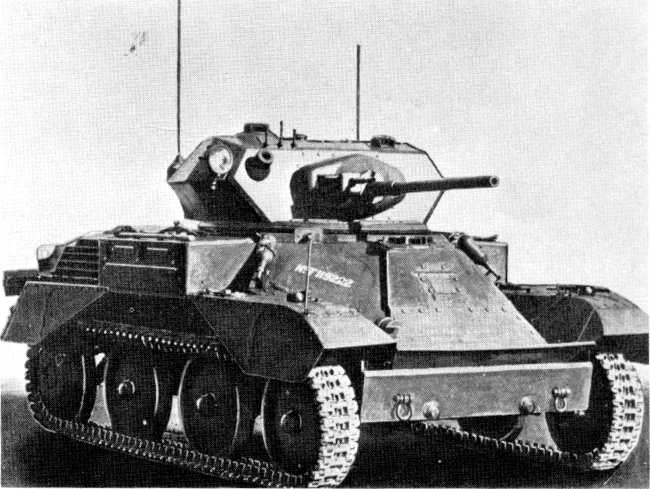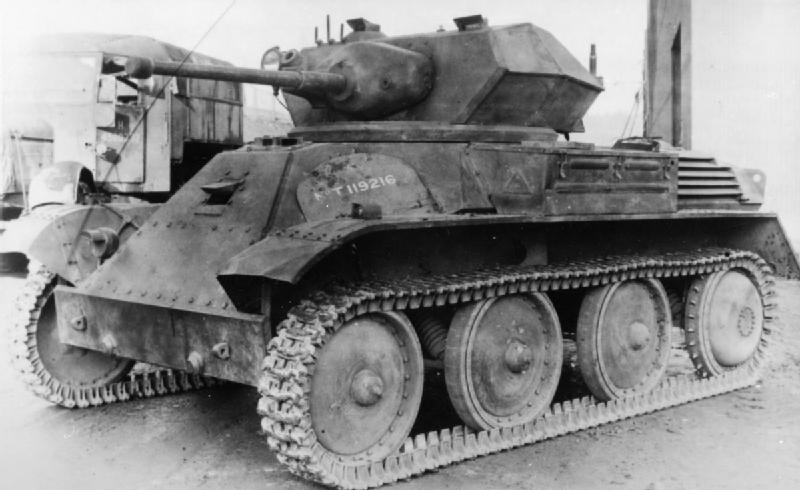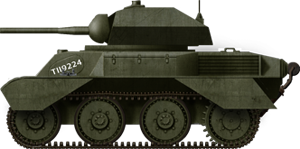The British airborne disaster tank
The Tank, Light, Mk VIII (A25), better known as "Harry Hopkins", was a British light tank made in just 100 vehicles by Vickers-Armstrong specifically for airborne operations. It was also the very last of the long line of British light tanks and successor to the Mk VII Tetrarch. Compared to the latter, it was larger and had a better armour. Submitted to the War Office in late 1941, the design was acepted and an order for 1,000 was approved by the Tank Board (War Office), later increased to 2,410 in November 1941. However production only started by June 1942 and early exercizes underline a great number of problems, requiring a stray of modifications of the design as production was ongoing. Complaints accumulated at the War Office from the Fighting Vehicle Proving Establishment. The issues were surch that only six Hopkins tanks had been delivered by mid-1943, and the serie went on until reaching 100 in February 1945 before being cancelled.By mid-1941 already, some in the War Office and British Army estimated that light tanks were no longer desirable, lacking armament and armour, and often foreshadow in their scout role by cheaper armoured cars. In general they performed poorly in many engagement. For the Mk VIII this meant they were already undesirable and were in addition obsolete when the production ended. In fact none ever saw combat. Reconversion plans were made by the War Office like having reconnaissance units fielding these, attached wings tests, to be towed as gliders, but nothing really worked. By default of other ideas, they were handed over to the Royal Air Force, and used use in airfield defence. The Mk VIII only variant was the short-lived Alecto self-propelled gun, using a howitzer for paratroopers close-support artillery in airborne operations, but only a few were produced, only tested, never fielded in active units.

Design
Vickers-Armstrong's take on the Harry Hopkins (named after the American President Roosevelt's chief diplomatic advisor) was an improvement of the Mk VII Tetrarch. After service reports of the latter, it was decided to improve armour protection in particular. Difficult to achieve for such a light vehicle by design, they succeeded in increasing the armour, notably the frontal hull and turret having now a thickness of 38 mm (1.5 in) and sides to 17 mm (0.67 in) thick, while the turret and hull were more sloped, artificially increasing armour thickness. Dimensions increase in a substantial amount, and the Harry Hopkins hull was 6 inches (0.15 m) longer, and 1 foot 3 inches (0.38 m) larger having quite an effect of their combat weight. These alterations however had a detrimental effect on their tactical mobility, as they were no longer air-portable, too heavy for the standard, roomy Hamilcar glider. This negated any aspects of airborne use and constrained their usage to light tank only.Propulsion wise, they had a 12-cylinder engine also found in the Tetrarch, but due to the vehicle increased weight, performances were much less impressive, with a top speed of 30 miles per hour (48 km/h), barely above a medium tank. Armament was the same, with a single 2-pdr (40 mm) or 1.6 in main gun, ubiquitous in 1941 but quite harmless of German tanks in 1944-45. It was coupled with a coaxial Besa 0.303 LMG. The Harry Hopkins also was plagued by the same odd steering system, mechanical, making turns by the lateral movement of road wheels bowing the narrow tracks. All eight road wheels were tilted fifferent ways in order to bend the tracks, to reduce the mechanical strain and power waste instead of braking a single track. However, an improvement over the Tetrarch, the Mark VIII steering system was power-assisted.
Production
Vickers-Armstrong submitted the Mk VIII design to the War Office in September 1941, and soon afterwards the Tank Board of the War Office ordered 1,000 tanks. The figure jumped by November to 2,410. Production was scheduled to start by June 1942 at 100 monthly. Metro-Cammell, a subsidiary of Vickers-Armstrong was chosen for the task. The specification A25 was given to the new tank, which entered the ordnance book. It was given the name of Harry Hopkins for political reasons.Production started as planned in June 1942. However as soon as they left the factory floor to be tested near the factory and in field trials (not even official ones), unspecified problems surged. This was crystallized into a minute sent to Winston Churchill in September 1942, from the Ministry of Supply. It was simply said that delivery was delayed by developmental problems. A further report by the War Office in December 1942 was more precise and categorical, listing a number of modifications to allow the vehicles for a large production.
The front suspension notably proved the most problematic, demanding extensive modifications. Many others were also listed. By July 1943, a new report from the Fighting Vehicle Proving Establishment indicated that many "serious defects" were still present in the production vehicles. This became so acute that trials were abandoned before completion. On 31 August 1943, six Mk VIII tanks had been delivered and returned to the workshop countless times, spanning more than a year. by that time the War Office estimated initially 100 would be operational in January 1943. Despite of this, the War Office retained the design and by November 1943 ordered 750 tanks. However the jagged developement history made that Metro-Cammell was forced to produce the vehicle despite all its flaws. The production run was officially cancelled in February 1945, with just 100 completed.

Fate
By mid-1941 the War Office and some in the Army decided that light tanks were too vulnerable to be used. This was grounded in reports of their performance in the Battle of France, despite the acknowlegement their used was the result of a shortage of tanks to engage the enemy, terefore improper use; Their reconnaissance prewar task dueing the war was soon filled by cheaper, faster scout cars with smaller crews and even better cross-country abilities. While a massve number of Mk VIII wasplanned for production at Metro-Cammell, their obsolescence was patent and cancellation came, whereas they never saw combat, at least first line.The requirement for a few light tanks organic to British armoured divisions, still existed in 1942-43, but it was met already by much better M5 Stuart light tank. By December 1942 a note started that light tanks were to be concentrated in reconnaissance regiments and special light tank regiments raised for one-off operations. In the end these consideration were brushed aside, and the Mark VIII built ended with the Royal Air Force, using them to defend airfields and airbases along their advance in Europe.
The Carrier Wing was also projecting the use of the tank, not by transporting ot, but towing it directly to the fight. For this, they needed a way to strap flying surfaces, wings and an armature to the Mk VIII. Since they were towed, there was no tails or elevons, no steering. A transport aircraft just towed them like they towed gliders, dropping them in flight, and the latter would glide into battle, for direct support in any airborne operation. The concept has been tested by the Soviets however with the Antonov A40 back in 1942, and tests had been disappointing to say the least. So, either because of internal dicussions, or this information, the small staff dedicated to this study dropped the matter. It seems, but it's not confirmed in any way, that a prototype was tested, and crashed.
Variant: Alecto SPG
The only variant known of the Mk VIII was the Alecto self-propelled gun.Also called at first "Harry Hopkins 1 CS" (CS for "Close Support"), it also had the General Staff designation A25 E2. The engneers razed the upper part of the tank and mounted a 95-millimetre (3.7 in) howitzer into the much lightened Mk VIII chassis. The howitzer was placed way down in the hull, armour was reduced to 4-10 mm (0.39 in) at best. Maximum speed was 31 mph or 50 km/h. The Alecto (One of the Erinyes in Greek mythology) was designed to replace US-built GMC half-tracks used by the airborne. Developement started in late 1942 and the War Office ordered 2,200 of them. In the end, with the demise of the Harry Hopkins, only a handfuk of prototypes were produced, and none saw service. After the program was cancelled they were converted into bulldozers, used by the Royal Engineers.


WW2 Tanks




























WW2 tanks posters

All Tiger tanks liveries.

Panther liveries and variants

WW2 Armour - All tanks











Tanks aces and single tanks series

Find more there

Museums, Movies, Books & Games
The Tanks and Armor in pop culture
Tanks and armored vehicles in general are only really grasped when seen first person: The mass, the scale, it's all there. Explore also the way tanks were covered in the movie industry, in books and in video games.Movies:
Best tanks movie on warhistoryonline.com
On imdb.com
On bestsimilar.com/
miltours.com
liveabout.com/
watchmojo.com
Video Games:
pcgamesn.com
historyhit.com
levvvel.com
vg247.com/best-tank-games
mmobomb.com/
alienwarearena.com

